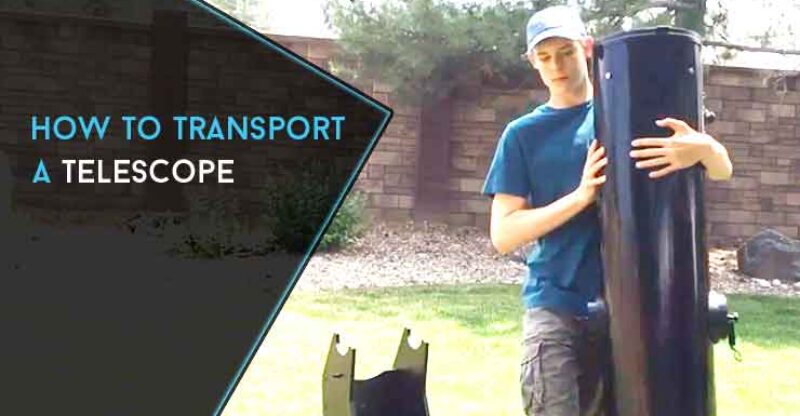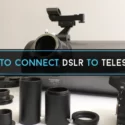How to Transport a Telescope: Easiest Guideline
Your telescope is one of the most expensive things you'll ever buy, and it's essential to take care of it.
How can you make sure that transporting your telescope home won't damage it? Well, don't worry! We're here to give you some tips on how best to get your new purchase back home without any problems whatsoever.
How long will this take? How much does this cost? How do I transport my telescope safely at night? All these questions are answered in our article below. So scroll down for all the information you need.
How to Transport a Telescope?
Transporting your telescope home safely can be tricky, especially if you live in an environment that doesn't have an abundance of public transportation options or friendly drivers.
We will ensure your new purchase arrives back home safely without any damage., so here are some tips on how best to make sure it gets there safe and sound.
Picking Your Telescope
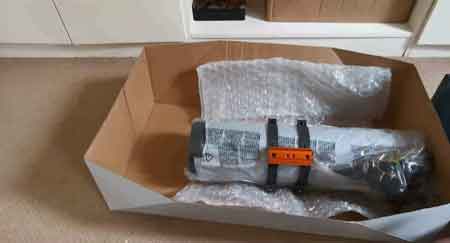
Make Sure Your Telescope is Properly Secured When the time comes to pick up your new telescope from the shop, ask the salesperson if they can remove any packaging material before loading it into your car. This will make it much easier to secure your device when you get home.
Some stores are also willing to load the telescope for you, but if they don't, just ask a friend or family member where the packaging is and ask them to remove it before you arrive.
Label All Edges You should never transport your telescope without covering all its exposed edges with something that can protect it from scratches or other kinds of damage.
How long it takes for a store employee to pick up your telescope will depend on what you order. Typically, scope stores offer a "pick up" option that ensures the store will remove goods from shelves and prepare them for transportation. How long it takes for a store employee to pick up your telescope will depend on what you order.
On a Car Roof
One of the easiest ways to transport your telescope is by placing it on top of your car. Whether you have a station wagon, an SUV, or a truck, the chances are that there will be enough space to fit in your new purchase.
How can you safely attach it? Well, for example, if we have a hard-shell case for our telescope, then all we need to do is place the telescope inside its carry bag and tighten the strap with which it comes.
Then all we need to do is secure it onto the roof with two or three separate straps from one side of our automobile to the other (we recommend attaching them at both front and back).
That way, even if we accidentally hit a bump while driving, there won't be any movement. How can you transport a telescope in a car? Just make sure it fits securely, and then all you need to do is drive carefully.
On a Van Roof
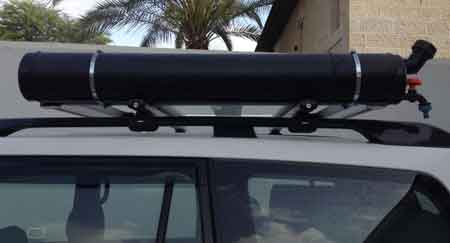
If we don't have an SUV or station wagon that can fit our new telescope on its roof, then we have no choice but to place it inside the back of our van.
How can we secure it for the ride home so that nothing happens to move around? One way would be to attach everything with some straps, like above.
And since telescopes are often heavy, another great option is to place them at the front of the vehicle and tie the straps from one side of your car to the other (front and back). Just make sure the telescope doesn't block your vision or that of your driver.
In the Backseat
If you have a station wagon or SUV (like above), then it's best to put the telescope on its roof as this is its safest place. But if our car doesn't have enough room for that option, we just need to make sure the telescope is placed on top of some blankets that can act as padding and protect it from any bumps.
How should we fix it so it won't move around? Just like before, with careful use of straps and maybe even bungee cords. You can transport a telescope in the backseat By placing it on top of some padding that will protect it from any bumps or movement.
On the Ground
Sometimes we don't have an option but to transport our telescope directly on the ground. You can do this without getting a scratch. First, always use a mat, so there's no dirt involved (even if we're going to take it inside immediately).
We can secure the telescope when carrying it with us, Just like how we do when it's in its carry bag. By using straps or bungee cords. We can transport a telescope on the ground With care and using good protection.
Transporting at Night
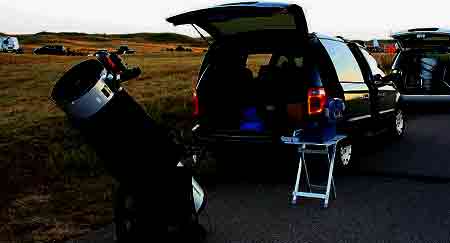
If you want to avoid heat exposure and possible damage, transporting your telescope during sunrise or sunset is always the best option.
How can you do this? Well, if it's a small telescope, then all we need to do is carry it in a bag like before (if that's the case). We can carry the telescope during sunset or sunrise and taking extra precautions by using extra padding to protect it from any bumps.
Transporting in the Rain
It is recommended never transporting a telescope during rain as they are not waterproof.
If you have to transport it in the rain, it is best to place your telescope in its carry bag and then cover it with an extra layer of padding (such as an old blanket or sheet). If it's raining, we can transport a telescope in the rain This way.
Additional Tips
Before Transporting
Before you transport your telescope home, make sure that any furniture or items are cleared from the back and that you're taking adequate precautions so that your purchase will arrive in one piece.
- make sure all the items it comes with are in the carry bag (including lens covers and tools)
- ensure that no screws or other parts are loose
- inspect your tripod to see if everything is intact
- consider strapping a mat around its legs for extra protection
Cost
It's impossible to give an exact cost because there are so many factors involved, but generally speaking, transporting your new telescope won't be cheap. You need to have money set aside so you can pay for storing your telescope away and insurance in case anything happens during transit.
How much you need to set aside depends mostly on how valuable your telescope is but usually, at least $10-15 USD per month should be enough (check with the specific company about rates).
You also have the option of hiring a professional moving or storage service provider, which might come cheaper than renting.
Important Safety Considerations
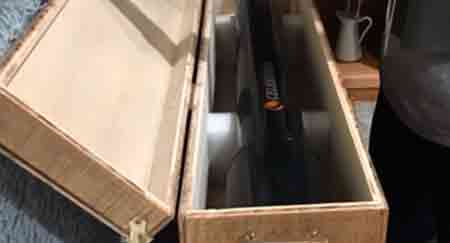
Strap your telescope down well, so it doesn't slide around the car. Always buy a hard-shell case to transport your telescope in (for extra protection).
Do not leave your telescope exposed under direct sunlight. Always move it somewhere safe, like indoors or in the shade. Transporting your telescope in the sunlight is never a good idea because of the risk that it will overheat.
All we need to do is plan our transport during the early morning hours or during evening hours.
FAQs
1. What is the Best Way to Transport a Telescope?
Answer: The best way to transport a telescope is by using the proper means. Storing it properly in the backseat of your car can be risky, so that's not going to work for you.
You need something that has more room, and if you're lucky enough to have a pickup truck or SUV with an attached, lockable cargo bed, you can just load up all your equipment.
Don't forget about those straps hanging down from the top of your vehicle. Use them. Those are perfect for securing large pieces of equipment like this one. If not, get a length of rope and tie it tightly around both ends at diagonal angles, ensuring no loops remain on either side.
Wrap one end over itself to create an edge and keep it from unraveling. Thread the end with the loop through the buckle on one end of your tie-down. Repeat for the other side.
2. What Should You be Wary of When Transporting a Telescope or Other Fragile Items?
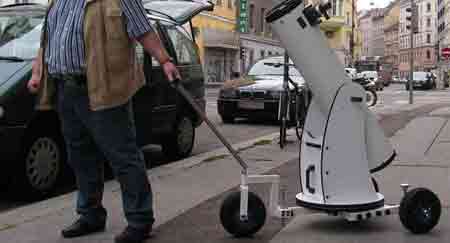
Answer: It is essential to keep your equipment secure during transportation, so there's no need to worry about things falling over in transit. Use tying straps and ropes where necessary.
It will also be helpful if you have someone traveling with you that can lend their assistance by helping spot something that slipped through the gaps of those tie-outs and tell you where it went down.
3. Is My Telescope Mount Safe Leaving it Outside?
Answer: It depends on the area you live in. If it is a freezing place, and it doesn't get that warm during the day, then yes.
If the ground under your mount freezes or has snow on top of it, then no. A telescope will be too heavy to move without damaging itself if there are any ice chunks underneath.
It won't matter what side of the equator you live on because telescopes can only operate in one hemisphere at a time. When they point north or south (depending on which side of the equator they are on), they can not see anything else unless they turn around (which would cause other sorts of problems).
4. Is It Possible to Use a Telescope in the Rain?
Answer: Yes, a telescope can be used in the rain. After all, you wouldn't want to miss out on any of the tremendous optical viewings since ants often like to walk across your eyepiece.
Some manufacturers recommend against using a telescope during heavy rains for fear it will short-circuit and get damaged with electrical surges that may occur during such inclement weather.
Rain may also wash away your ability to see faraway objects at night or star gazing because water droplets can scatter light.
That said, it's possible to set up your telescope under an adequate roof before long stretches of rainfall so that you're still able to use it after the storm has passed.
It would be best if you could save yourself from having to transport it during the rain.
If you have to carry your telescope to a new location, make sure that it's covered with a waterproof bag or at least by your jacket to keep off the rain. If your telescope is wet or damp, wipe it gently with a dry towel, and don't try to adjust any screws until it dries off completely.
Last Thoughts
You've read a lot of good information today on how to transport a telescope. We hope it's been helpful and informative, but if you still have questions, we're here for you! And we wish you well with transporting your telescope. Thanks again, stay tuned and good luck 🙂

